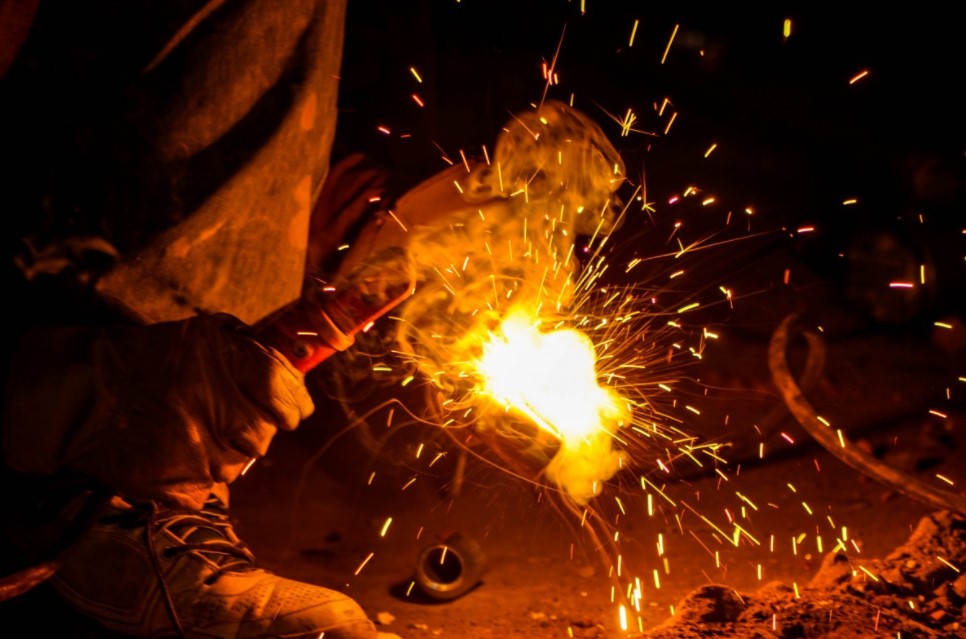Inspections focus on occupational lung disease
Contents |
[edit] Introduction
The Health and Safety Executive (HSE) is inspecting fabricated metal businesses across Great Britain to check that they are managing the respiratory risks of welding fumes and metalworking fluids.
In 2020, 12,000 people in the UK died from lung diseases thought to be linked to past exposure associated with work in a range of sectors. There is scientific evidence that exposure to welding fumes can cause lung cancer, and exposure to metalworking fluids can cause a range of lung diseases, including occupational asthma and occupational hypersensitivity pneumonitis (OHP), which are debilitating diseases with life changing impact.
[edit] High risk sectors
On 4 May 2021 - World Asthma Day 2021 - it was announced that health and safety inspectors across the country would be targeting businesses whose workers are involved in welding and use metalworking fluids. The purpose of the inspections is to check that employers are complying with the welding fumes and metalworking fluid guidance. During the visits, duty holders will need to demonstrate they have measures in place to manage risks to protect their workers from occupational lung disease and ‘WorkRight’ to keep workers healthy and safe.
Inspectors will be looking for evidence that employers and workers know the risks, plan their work and use the right controls to protect health. If necessary, they will use enforcement to make sure workers are protected.
While the primary focus will be on lung health during this programme of inspections, if an HSE inspector identifies any other areas of concern, they will take the necessary enforcement action to ensure these are dealt with. This will include making sure that businesses are COVID-secure and are doing all they can to protect their workers from the risk of infection from COVID-19.
[edit] Proactive behaviours
The inspection programme will be supported by HSE’s ‘WorkRight’ campaign, set up to influence employer behaviour by encouraging fabricated metal businesses to download free guidance and advice, increasing their knowledge and capability to protect workers’ health.
HSE’s Acting Head of Manufacturing and Utilities Unit Clare Owen, said, “Our inspection initiative aims to ensure employers and workers are aware of the risks associated with the activities they do. They must recognise these dangers and manage these risks through reducing exposure. Duty holders need to do the right thing, for example, through completing a risk assessment, ensuring workers are trained and reducing exposure using local exhaust ventilation (LEV) and using suitable respiratory protective equipment (RPE) to protect workers, where required.”
[edit] Related articles on Designing Buildings Wiki
- Construction dust.
- Construction health risks.
- Deleterious materials in construction.
- Filtering facepieces.
- Hazardous substances.
- Health and Safety Executive HSE.
- Health and safety inspections.
- Notification to HSE.
- Performance of FFP3 disposable respirators.
- Reporting accidents and injuries on construction sites RIDDOR.
- Volatile organic compounds VOC.
- Welding.
Featured articles and news
RTPI leader to become new CIOB Chief Executive Officer
Dr Victoria Hills MRTPI, FICE to take over after Caroline Gumble’s departure.
Social and affordable housing, a long term plan for delivery
The “Delivering a Decade of Renewal for Social and Affordable Housing” strategy sets out future path.
A change to adoptive architecture
Effects of global weather warming on architectural detailing, material choice and human interaction.
The proposed publicly owned and backed subsidiary of Homes England, to facilitate new homes.
How big is the problem and what can we do to mitigate the effects?
Overheating guidance and tools for building designers
A number of cool guides to help with the heat.
The UK's Modern Industrial Strategy: A 10 year plan
Previous consultation criticism, current key elements and general support with some persisting reservations.
Building Safety Regulator reforms
New roles, new staff and a new fast track service pave the way for a single construction regulator.
Architectural Technologist CPDs and Communications
CIAT CPD… and how you can do it!
Cooling centres and cool spaces
Managing extreme heat in cities by directing the public to places for heat stress relief and water sources.
Winter gardens: A brief history and warm variations
Extending the season with glass in different forms and terms.
Restoring Great Yarmouth's Winter Gardens
Transforming one of the least sustainable constructions imaginable.
Construction Skills Mission Board launch sector drive
Newly formed government and industry collaboration set strategy for recruiting an additional 100,000 construction workers a year.
New Architects Code comes into effect in September 2025
ARB Architects Code of Conduct and Practice available with ongoing consultation regarding guidance.
Welsh Skills Body (Medr) launches ambitious plan
The new skills body brings together funding and regulation of tertiary education and research for the devolved nation.
Paul Gandy FCIOB announced as next CIOB President
Former Tilbury Douglas CEO takes helm.
UK Infrastructure: A 10 Year Strategy. In brief with reactions
With the National Infrastructure and Service Transformation Authority (NISTA).























